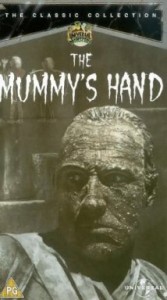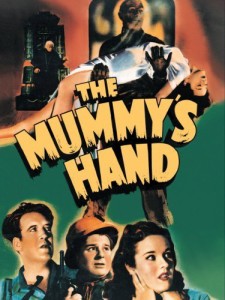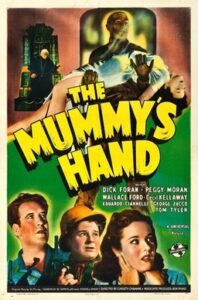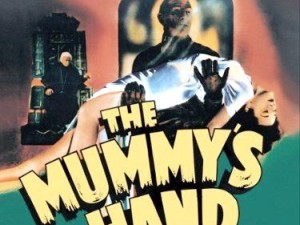The Mummy’s Hand *** (1940, Dick Foran, Wallace Ford, George Zucco, Cecil Kellaway, Peggy Moran, Tom Tyler, Eduardo Ciannelli) – Classic Movie Review 2816
‘The tomb of a thousand terrors!’
Director Christy Cabanne’s lusty 1940 American black-and-white horror sequel The Mummy’s Hand is only 67 minutes long but re-uses more than 10 minutes of footage from Universal Pictures’ The Mummy in the first of the B-movie sequels to the popular 1932 original. It was the financial success of Universal’s Son of Frankenstein and The Invisible Man Returns led them to revive the dormant Mummy idea – as long as it was cheap enough. And The Mummy’s Hand was certainly cheap enough at just $84,000, thanks to ingenious recycling. Ancient ideas, old sets, previous footage and an earlier score are all gleefully re-assembled.
The story is by Griffin Jay, and the screenplay by Griffin Jay and Maxwell Shane, relying in part on the 1932 screen story and screenplay. The two screen-writers’ plot brings together every element of the genre they can think of as an archaeological expedition receives the unwanted attentions of Kharis the living Mummy (Tom Tyler) when they open a sacred tomb.
The actors and the screenplay use every trick in the book to try to scare us witless. Unfortunately some of the film is partly comic, making the mistake of playing for unwanted broad laughs. The film-spoiling comic relief is so dreadful that it is a relief when it stops. But happily most of the film is all mainly horrific, leading to a fairly lusty climax with several satisfactorily grisly demises. Ironically, the 10 minutes of flashback footage from The Mummy, including Boris Karloff being punished by being buried alive and wrapped for burial, is a highlight of this second film.
Dick Foran and Wallace Ford (born Samuel Grundy in Bolton, Lancashire) handle the rough comedy as jobless archaeologists Steve Banning and Babe Jenson, who find evidence of the Egyptian burial place of ancient Priestess Ananka.
A magician called the Great Solvani, aka Tim Sullivan (Cecil Kellaway, born in South Africa) is persuaded by Banning and Jenson to finance and join the archaeologists’ expedition to the desert in search of Ananka’s sarcophagus, along with his daughter Marta (Peggy Moran). They are terrorised by a sinister Egyptian mystic called Andoheb (George Zucco) who is ordered by his High Priest (Eduardo Ciannelli) to guard over the Mummy of Kharis (Tom Tyler), who can be revived by burning a handful of tana leaves. The movie introduces the idea of tana leaves as integral to the Mummy’s survival.
Andoheb joins the expedition disguised as the professor of Egyptology at the Cairo Museum, and Kharis is ordered to kill off expedition members Dr Petrie (Charles Trowbridge) and Ali (Leon Belasco), while Andoheb is attracted to Marta, planning to kidnap her and make her immortal (‘You are very beautiful… so beautiful I’m going to make you immortal’).
Foran and Moran are bland and boring as hero and heroine, while Wallace Ford is particularly awful with his tiresome rough comedy turn. But the film is lucky to have Zucco aboard because his silky sinister turn is the film’s most effective performance, along with Tyler’s.
The movie also features Eduardo Ciannelli as the old High Priest, Charles Trowbridge as Dr Petrie, Sig Arno [Siegfried Arno] as The Beggar, Leon Belasco as Ali, Eddie Foster as Egyptian, Michael Mark as Bazaar Owner, Mara Tartar as the Girl, Harry Stubbs as Bartender, Murdock MacQuarrie as Priests, Jerry Frank as an Egyptian thug, and Ken Terrell as an Egyptian Thug.
Jack P Pierce’s painstaking cotton-strip Mummy make-up is used on Tyler for close-up and medium shots. To save time and money, the actor wears a rubber mask in long shots. Tyler’s eyes and the inside of his mouth are blacked out frame-by-frame in almost all close-ups to make him seem scarier. And it works! Cowboy star Tyler is a good and effective Mummy in his one-off turn.
Recycling old sets as well as footage, Universal originally built the tomb set for Green Hell and is appears again in other of their films. It is also ironic that the tomb set is a highlight of this second film. It also reuses nearly the entire score by Frank Skinner from Son of Frankenstein, another highlight of this second film.
The excavation scenes are shot on the Universal back-lot in a rocky and desert-like section of the hills.
It was made on a low budget of $84,000 (including $4,000 over-budget and slightly over-schedule). Filming began towards the end of May 1940 and production continued into mid-June, leading the crew to film into overtime hours. It was released on 20 September 1940, and proved profitable enough to re-launch Universal’s dormant Mummy franchise.
The next sequel is The Mummy’s Tomb (1942), followed by The Mummy’s Ghost (1944), The Mummy’s Curse (1944), all with Lon Chaney Jr.
Peggy Moran recalled that she had to be on set at 6am to do hair and makeup and that filming began at 8am and would occasionally work as late as 4am the next day: ‘They could do that with people like me because we were under contract.’ She found Dick Foran ‘very nice and friendly’ and Wallace Ford ‘very funny always’ but never met Tom Tyler without his Kharis make-up on, as he also had to be at the studio at 4am and couldn’t talk with his make-up on.
In all four Kharis movies, the Mummy has a disfigured right arm. Tyler’s is bent at the elbow with his hand on his chest, but he is quick to use the arm fully when picking up the heroine.
When Marta (Moran) goes back to retrieve the investment money, she uses a revolver that is only a six-shooter but fires nine shots at the door, and there are still enough left over to threaten the bad guy.
Does somebody actually say ‘And now we’re stuck with a dame!’ and ‘Oh, that’s just like a woman. When the shooting’s all over and everything, they pass out.’?
© Derek Winnert 2015 Classic Movie Review 2816
Check out more reviews on http://derekwinnert.com





